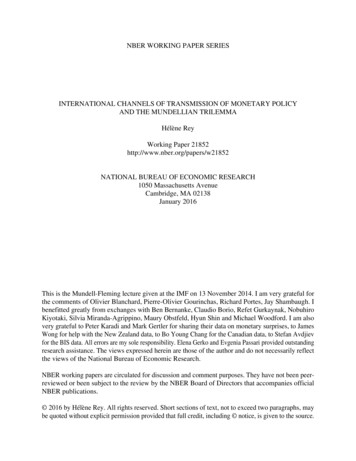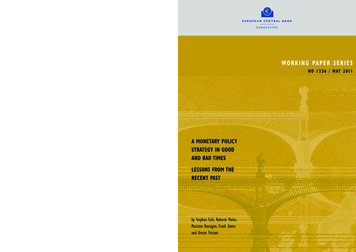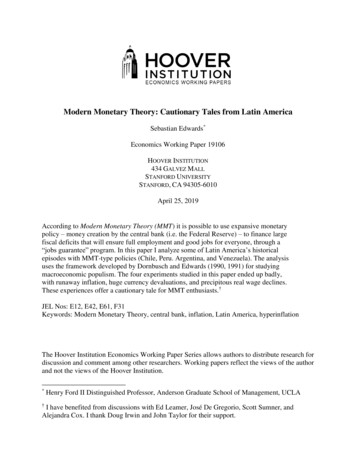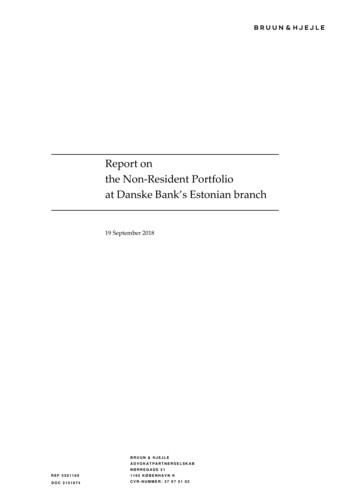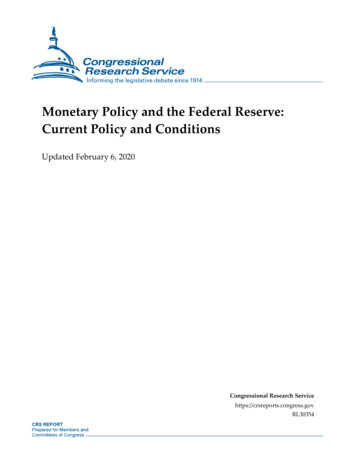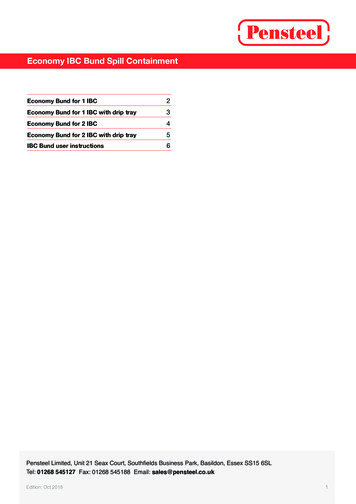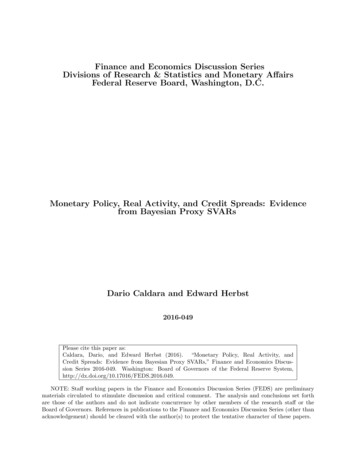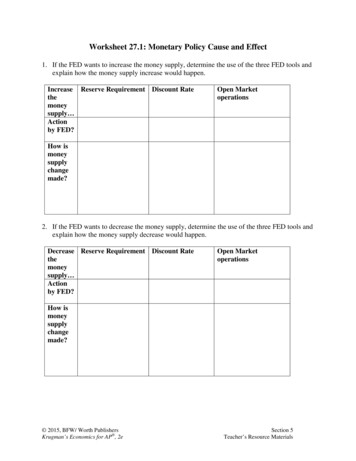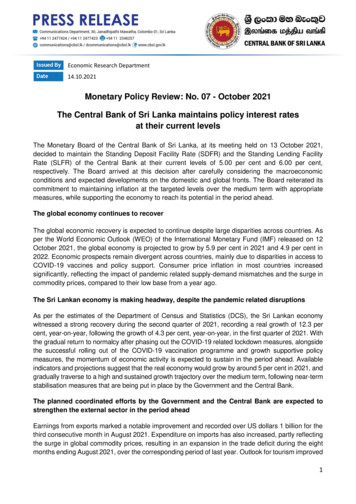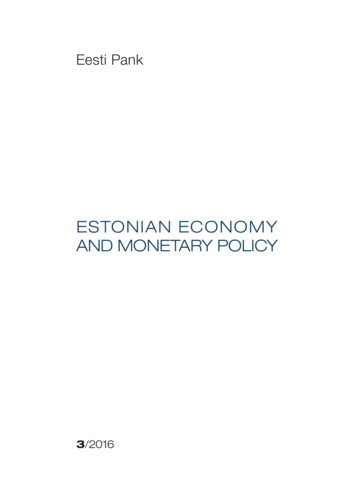
Transcription
Eesti PankESTONIAN ECONOMYAND MONETARY POLICY3/2016
The Estonian Economy and Monetary Policy is an Eesti Pank review released four times a year thatsummarises the main recent events in the global and Estonian economies. Twice a year, in June andDecember, the review also contains the forecast for the Estonian economy for the current year andthe next two calendar years.The Estonian Economy and Monetary Policy is available at http://www.eestipank.eeand is free of charge to subscribers.Subscriptions of printed versions:Fax: 372 668 0954E-mail: publications@eestipank.eePrintISSN 1736-7867OnlineISSN 2504-6012Layout and design Urmas RaidmaPrinted by Folger Art
CONTENTSSUMMARY. 4THE EXTERNAL ENVIRONMENT. 5THE GLOBAL ECONOMY. 5THE EURO AREA. 7Box1: The uncertainty stemming from political riskswill affect the European Union in the near future. 9Box 2: The monetary policy environment of the euro area. 10ESTONIA’S MAIN TRADING PARTNERS. 13THE ESTONIAN ECONOMIC ENVIRONMENT. 16ECONOMIC ACTIVITY. 16Box 3: The economic impact of BREXIT on Estonia. 18Box 4. The impact of capital intensity and smartness on labour productivity. 19DOMESTIC DEMAND. 22EXTERNAL BALANCE AND COMPETITIVENESS. 24Box 5: The contribution of institutional sectors to the dynamics of the current account. 26THE LABOUR MARKET. 27PRICES. 30Box 6: The impact of structural changes in consumer spending on consumer prices. 31GENERAL GOVERNMENT FINANCING. 33
SUMMARYThe economy of the European Union andthat of the euro area have been moving in thedirection of more certain growth in recentyears, though growth in the second quarterwas again slower than in previous quarters and uncertainty about the future wasincreased by the referendum in the UnitedKingdom in June, in which the voters chose toleave the European Union. Although it is not yetclear what form cooperation between the UnitedKingdom and the European Union will take infuture, the referendum result led to a suddensurge in volatility in stock markets and was alsoreflected in a drop in the value of the pound sterling. At the start of September the EuropeanCentral Bank lowered its outlook for growth in theESTONIAN ECONOMY AND MONETARY POLICY 3/2016United Kingdom in response to the referendumresult, and did the same for the growth forecast for the euro area, mainly because of weakexternal demand.4Revised data put growth in the Estonianeconomy at 0.8% in the second quarter,leaving it below its long-term potential.Growth was broadly based though, as value addedgrew in most sectors and the main obstacle toachieving potential growth was the decline in valueadded in energy, mining and real estate activities.All three are capital-intensive industries wherelabour costs are a very small part of total costs,meaning the connection to the labour marketis weak. The better progress in the other, morelabour-intensive, sectors explains at least partiallywhy the number of people in employment andthe average wage have increased even as overallfigures for economic growth have been low. Theincrease in unfilled positions in the second quarteralso shows that the upward pressure on domesticwages caused by labour shortages has probablynot yet faded.Although the unit labour cost based realeffective exchange rate of the euro hasappreciated for Estonia, exporting companies consider their competitiveness in theEuropean Union market and further afield tobe stronger than in the beginning of the year.This is in line with a revitalisation of Estonian trade inthe second quarter, as around 4% more goods andservices were exported than a year earlier. Importsgrew by even more at the same time, but the currentaccount remained in surplus even so. The secondquarter also saw an increase in fixed capital formation, which was earlier indicated by data for importsof capital goods and VAT declarations. Alongsideincreased household investment in housing, corporate investment also grew, which is a necessarycondition for the economy to grow faster. Increasedcorporate investment makes it more likely that thepersistent gap of recent years between economicgrowth and wage growth will be closed throughincreased labour productivity rather than througha sharp braking of wage growth.Having fallen for more than two years, pricesrose in August and took consumer price inflation back into positive territory. However, theprice level has been rising steadily on a monthlybasis since the start of the year, and in a littleover half a year consumer prices have climbedby around 2%. Price pressures have remainedweak despite rapidly rising wage costs andincreasing demand. This is partly because profitmargins have been slimmed, and partly becausethe oil price has been low and prices have risenonly slowly for imported commodities. Theconsequence of the fall in prices in the meantime was that consumer prices were at a similarlevel in August this year to where they were atthe start of 2013. During this time the averagegross wage increased by 20% however, meaningthat the average purchasing power of residentsincreased by about one fifth in three years, whichhas resulted in fast growth in retail sales and inprivate consumption.Strong growth in wage income and consumption has boosted tax revenues. Tax revenueshave also been raised by higher excise ratesfor alcohol, tobacco and fuels. In the first half ofthe year, general government income exceededexpenditure and for the year as a whole thebudget should remain in surplus. Growth ingeneral government spending has been seriouslylimited by a reduction in investment, but the cutin the numbers employed by government institutions in an effort to keep the size of the publicsector the same relative to a shrinking populationhas also had an impact.
THE EXTERNAL ENVIRONMENTTHE GLOBAL ECONOMYFigure 1. Stock market volatility indexesin the USA and EuropeThe second quarter of 2016 saw increasinguncertainty in the development of the globaleconomy as several negative risks realised.One of these was the outcome of the Brexitreferendum in the United Kingdom in June, whichsaw the country vote to leave the European Union.This came as something of a surprise to financialmarkets, leading to increased volatility in stockmarkets (see Figure 1). The price of oil also startedto fall again in July, having risen in the first quarter.Increased uncertainty will affect investment activityand consumption going forward. The IMF1 hasreduced its outlook for global growth in the WorldEconomic Outlook (WEO) by 0.1 percentage pointVIX (United States)V2X (Europe)4035302520151001.201507.2015Source: BloombergLast observation 01.09.2016from April to 3.1% for 2016 (see Table 1). Globaleconomic growth is affected negatively aboveall by the worse outlook for growth in advancedeconomies. Geopolitical tensions continue topose risks to global growth too.01.201607.2016several member states and by fiscal policy challenges. Unsurprisingly the outlook for growth hasbeen lowered the most for the United Kingdom.Table 1. GDP growth in different regions in 2005 - 2016 (change, %)*201120122013201420155.44.23.43.33.43.12016 Q12016 Q220163.1Advanced economies3.11.71.21.11.81.91.8Emerging markets and developingeconomies7.56.35.25.04.64.04.1Euro area2.11.5-0.9-0.31.12.01.7 (0.5)1.6 (0.3)1.6United States2.51.62.21.52.42.41.6 (0.2)1.2 (0.3)2.2China10.69.57.87.77.36.96.7 (1.2)6.7 (1.8)6.6Japan4.7-0.51.71.40.00.50.1 (0.5)0.8 (0.2)0.3United Kingdom1.52.01.22.22.92.22.0 (0.4)2.2 (0.6)1.7* GDP at constant prices; quarterly growth over the last quarter of the same year is shown in brackets, 2016 is WEO forecastSources: World Economic Outlook Update, July 2016, Eurostat, National StatisticsThe rate of growth in advanced economiesremained slower than markets expected inthe second quarter, mainly because of weakexternal demand. Growth was again basedmainly on domestic demand. Economic activityin the USA was a little weaker than expected,leading the IMF to adjust growth for 2016 for theUSA slightly downwards in its WEO. Growth inthe euro area meanwhile has been reassessedupwards because of stronger domestic demandand increased investment, though there is quite alot of uncertainty about the future because of theimpact of Brexit. Growth in the euro area is alsothreatened by problems in the banking sectors ofAs inflation remains low in advanced economiesand the risks to growth have increased, centralbanks in the United Kingdom and Japan haveincreased their monetary policy stimulus further orcut interest rates.1 World Economic Outlook Update, IMF, July 2016.2 The Markit US Manufacturing PMI.Growth in the US economy stood at a quarterly 0.3% in the second quarter, whichwas just ahead of the 0.2% posted in thefirst quarter. The strongest driver was privateconsumption, with net exports also contributing.Industrial production increased with supportmainly from manufacturing and mining. At thesame time, the purchasing managers index 2ESTONIAN ECONOMY AND MONETARY POLICY 3/20162010World5
ESTONIAN ECONOMY AND MONETARY POLICY 3/20166was down slightly in August as new orders werereduced and recruitment plans scaled back.The consumer confidence indicator 3 also weakened slightly in August. Exports have increaseda little in recent months, but this is restricted byweak external demand, especially from Asia andCanada. The labour market remains strong in theUSA, with unemployment low at 4.9% and wagegrowth picking up a little in the summer. However,inflation has not received enough support fromthe labour market, because yearly growth inconsumer prices slowed in July to 0.8%, primarilybecause of falls in energy and food prices andhousing costs. The strong labour market is themain reason why the probability has increasedof the US Federal Reserve raising its monetarypolicy interest rates further this year.investment in the construction sector accountingfor a large part of it, but trade had a negativeimpact on economic growth. Household confidence 6 did fall after the Brexit vote, but recovereda little in August and currently remains above itshistorical average. However, households oftenreact to changes in the economy with a lag, soit may take some time before households start tolimit their spending. The July survey of economicagents by the Bank of England found that uncertainty had indeed increased for companies, andrecruitment and investment plans have beenscaled back somewhat. The labour market in theUnited Kingdom remains strong, with unemployment low at 4.9% and employment high by historical standards at 74.5%. Inflation picked up a littlein July as consumer prices were up 0.6% overthe year because of higher prices for transportGrowth slowed in the Japanese economy inthe second quarter to a quarterly 0.2%, havingbeen 0.5% in the first quarter. This was mainlybecause of the negative impact from exports.The exporting sector, especially the productionof cars and electronics, has been hurt by thestrong yen and the scandal around car emissions. Growth was lifted by domestic demandand investment in housing. A business surveyin August4 showed that confidence had fallenin manufacturing to a record low level though,reaching a point last seen in April 2013. Deflationcontinued for a fifth month as falling transportand housing costs pulled core inflation downto -0.4% in July. Unemployment was alreadylow in Japan and it fell further to 3% in July andthe rate of wage growth picked up a little. TheJapanese government published a new supportprogramme for the economy worth 28 trillion yenin August to supplement the decision taken bythe Japanese central bank in July to enhance itsasset purchase programme 5.and for hotel and restaurant services. The Bankof England cut its monetary policy interest ratesat the start of August from 0.5% to 0.25%, andincreased its asset purchase programme so asto give support to the economy.Growth accelerated in the second quarter inthe United Kingdom to a quarterly 0.6% from0.4% in the first quarter. Household spendingincreased faster than expected and rapid growthcontinued in retail sales in July. Investment growthalso had a positive impact on the economy, with3 Surveys of Consumers, University of Michigan.4 The Reuters Tankan.5 Purchase volumes were increased for both the stock index(ETF) and the US dollar lending programme.Growth in emerging economies so far in 2016has been in line with expectations, or in somecountries such as China, Russia and Brazileven ahead of expectations, mainly becauseof government stimulus. The Chinese economygrew by a quarterly 1.8% in the second quarter,which was more than markets expected andsignificantly more than the 1.2% recorded in thefirst quarter. Growth in China has remained slowerthan in earlier years, largely because of structuralchanges in the economy. Slower growth in Chinaaffects global industrial output volumes negatively too. Chinese growth has picked up in recentmonths though, primarily on the back of majorinfrastructure investments, but it is debatablehow sustainable the Chinese policy of supportingfinancial leverage in the real estate sector is.A higher oil price has supported economicactivity in Russia and other oil exporting countries this year, but the risks from political tensionsremain significant in those regions.Global stock indexes fell quite steeply in Juneafter the referendum in the United Kingdom,but they recovered rapidly afterwards. Interestrates on the sovereign bonds of advanced6 GfK Consumer Confidence Index.
tries have also fallen quite notably.The main development in commoditiesmarkets in the second quarter was the dropin the oil price. It remains higher than it wasat the end of last year though. The oil pricefell partly in response to the uncertainty in themarkets that followed the Brexit vote, but it alsocame under pressure from increases in reservesin the US oil sector and from reduced demandfrom China. Oil production by OPEC hit an eightyear high at the same time. Among preciousmetals, gold and silver saw prices continue torise in the summer months. Risk aversion amonginvestors led them to invest more in silver, withthe result that the price of silver rose by 17% ina month from June to July. Prices of industrialmetals have also mainly been rising, but prices foragricultural produce, primarily cereals, have beenpushed down by overproduction (see Figure 3).THE EURO AREAThe euro area economy grew in the secondquarter by 0.3% and by 1.6% over the year.Growth was slower than in the first quarter, whenit had exceeded expectations at 0.5%. Euro areagrowth continued to be underpinned in the first halfof the year by domestic demand, and the contribution of net exports to yearly growth remained negative. However, quarterly growth was given a positiveboost by net exports in the second quarter, whichhelped to prevent growth slowing more sharply fromthe previous quarter. Export growth in the secondFigure 2. World stock indexes (03.01.2015 100%)160%S&P 500Nikkei 225SSE CSI 300Euro Stoxx 5Source: BloombergLast observation 05.09.201601.201607.2016Figure 3. Commodity price indexes, USDindustrial commodities index, Jan 2013 100food commodities index, Jan 2013 100oil price, USD/barrel1201008060402002013201420152016Sources: IMF, Bloombergquarter was supported by improved competitiveness in the euro area among other things due tothe earlier depreciation of the euro. The latestactivity indexes suggest that moderate economicgrowth continued in the third quarter. The increasein uncertainty occasioned by the decision of theUnited Kingdom to leave the European Union hasnot had a significant negative impact on sentimentindexes in the euro area. The Markit purchasingmanagers index (PMI) was a little lower in Augustthan in July at 52.9 points, but it remained above50, indicating continued growth. The opinions givenfor the index did reflect some increase in pessimismabout the future (see Box 1 on European politics).Activity indexes for the first two months of the thirdquarter imply that growth will continue in the euroarea at a similar rate to that of the second quarter.ESTONIAN ECONOMY AND MONETARY POLICY 3/2016economies fell to record lows however, whileseveral leading stock indexes, such as the DowJones and the S&P 500, climbed to record highs(see Figure 2). Optimism passed on into the stockmarkets of Europe and Asia, mainly in responseto hints from central banks of further stimulus tocome, though shares were also helped by bettercorporate results for the second quarter thanexpected, especially in the USA. The Europeanbanking sector suffered a blow after the Brexitvote, especially in Italy and in member stateswhere the latest stress tests had revealed problems at banks. Interest rates on sovereign bondsmostly fell in July and August, but the changewas generally more modest than that in June.Interest rates remained negative for several countries however, including for the ten-year GermanBund, and rates on bonds for peripheral coun-7
Labour markets in the euro area continuedto improve. The unemployment rate fell in May to10.1%, and remained at the same level in June andJuly. The share in unemployment of the long-termunemployed, who have been out of work for over12 months, remained above 49% in the first quarter,but has still fallen over the past year. There is stilla lot of variation between labour markets acrossthe countries of the euro area, as the lowest unemployment rates are close to 4% in countries likeGermany and Malta, while the highest rates reachor even pass 20% in countries like Greece andSpain. Employment increased by 0.3% in the firstquarter, and yearly growth was 1.4%. Yearly growthin employment was positive in all the countries ofthe euro area. The number of people in employment in the first quarter stayed at 1.1% below thelevel seen before the economic crisis (see Figure4). With unemployment rates high and inflationESTONIAN ECONOMY AND MONETARY POLICY 3/2016low, wage growth has continued to be slow, andit slowed further in the first quarter, from a yearly1.3% in the previous quarter to 1.2%. Businesssurveys indicate that wage growth is not expectedto accelerate significantly in the near future.8Increasing employment and low energy pricesboosted purchasing power and so privateconsumption, which was again the main factordriving economic growth in the first quarter. Privateconsumption in the first quarter was 0.6% aboveconsumption in the previous quarter. Consumptiongrowth was a little below expectations in thesecond quarter though, as it slid to 0.2%. Retailsales were on average up 1.5% over the year inthe second quarter. Growth in retail sales hasslowed from what it was in the second half of lastyear, but still remains stronger than in recent years.The consumer sentiment survey of the EuropeanCommission showed some decline in consumerconfidence in the second half of summer, but theconfidence index remained above its long-termaverage even so. The purchasing managers indexcalculated from the sales indicators of the threelargest countries in the euro area climbed in Augustto its highest level of the past ten months. This risewas driven by increased activity in the retail sectorin France and Germany.The contribution of investment to economicgrowth remained positive in the first half ofthis year, but growth in investment slowed inthe second quarter. Investment was encouragedFigure 4. Employment and unemploymentin the euro areaunemployment (right scale)employment (2008 Q1 100) (left 201420162%Source: EurostatFigure 5. Investment in the euro areafixed capital investment (2008 Q1 100) (left scale)capacity utilisation (right 20142016Sources: Eurostat, European CommissionFigure 6. Euro area inflationall itemscore inflation3%2%1%0%-1%20122013Source: Eurostat20142015201660%
by low interest rates and the production capacityutilisation rate, which stood above its historicalaverage because demand grew while investmentactivity has been modest since the crisis. Fixedcapital formation increased by 0.4% over the firstquarter, and by a yearly 2.5%. Increased uncertainty in the second quarter about the future forthe European Union and the poorer outlook forthe external environment put a brake on investment growth, and yearly growth dropped to 2.4%.Investment in the second quarter was some 12%below where it was in the first quarter of 2008,before the crisis hit (see Figure 5).Inflation remained close to zero in the euroarea in the first half of the year. Consumerprice inflation was 0.2% in both July and August(see Figure 6). Inflation continued to be pulled downmainly by falling energy prices, while food priceinflation was a little above where it started the year.With the more volatile components of inflation, theprices of energy and food, excluded, core inflationhas been at 0.8% and 0.9% in recent months. Theprice expectations for the next 12 months revealedby the consumer sentiment surveys were down alittle in the second half of summer, though the shareof consumers expecting prices to rise was largerthan at the start of the year even so. The long-terminflation expectations in surveys of professionalforecasters remain stable at 1.8%. In contrast,financial derivatives that reflect inflation are clearlydown on the start of the year, and the five-year inflation expectations for the next five years revealed byinflation swaps were at all-time record lows in July(see Box 2 for more on the euro area monetarypolicy environment).BOX 1: THE UNCERTAINTY STEMMING FROM POLITICAL RISKS WILL AFFECTTHE EUROPEAN UNION IN THE NEAR FUTUREEurosceptic parties are also calling for referendums to be held in other European Union memberstates. Marine Le Pen, leader of the anti-immigrant Front National in France and candidate forthe national presidency next spring, has moved to broaden her appeal by promising a similarreferendum on European Union membership to that in the United Kingdom. The right-wingFreedom Party in the Netherlands and the Northern League in Italy have also promised to holdreferendums if they win parliamentary elections. However, it is still unlikely that further referendums on European Union membership will be held as organising them is a complicated politicaland legal process that requires parliamentary approval, wide popular support, and, in mostcountries, a change to the constitution. Although there are more and more Eurosceptic people,the majority of citizens still remain pro-European, as the largest share have a neutral or positiveimage of the European Union and as many as eight out of ten Europeans favour the free movement of labour within the European Union7. Even as Euroscepticism has increased, support forthe euro has remained relatively stable in euro area member states 8. Despite this, the questioning7 The Eurobarometer sentiment survey of July 2016 showed 72% of European Union citizens had a neutral or positive imageof the Union, half of those surveyed have a positive view of the European Union’s future, and eight Europeans out of tensupport the free movement of labour inside the European Union. Popular support for the euro has also been relatively stable,remaining between 53% and 82% in euro area member states.8 The Eurobarometer put support for the single currency at 72% among citizens of countries in the euro area in July 2016.ESTONIAN ECONOMY AND MONETARY POLICY 3/2016The decision of the United Kingdom to leave the European Union shook Europe and createda lot of uncertainty. The initial bitterness in Brussels and other European Union capitals wasreplaced by a sense of acceptance over the summer. The new British prime minister TheresaMay has confirmed that the decision to exit the European Union is irreversible, but the exit negotiations will not start in 2016. There is a great deal of uncertainty in the European Union followingthe decision, partly because it is not known exactly how the exiting process will unfold and whatform of cooperation and partnership there may be in the future, and partly because the departure of the United Kingdom will seriously affect the European Union itself, as Eurosceptic opinionin Europe has highlighted several significant political risks.9
of European Union membership has increased public uncertainty. Political uncertainty alsorestricts the outlook for economic growth, as confidence is needed for investments to be made.Increased support for extremist parties may lead to fragmentation within parliaments and topolitical stalemate. Elections in countries in Southern Europe have been particularly notable aspopulist parties with radical left or right-wing views have crossed the parliamentary threshold.This has made it harder to create governing coalitions. Parties in Spain for example have notmanaged to form a government following general elections in December 2015 and June 2016.This has meant a lost year for efforts to improve the living standards of Spanish citizens, becausethe provisional government does not have a mandate to change the budget or take any decisions on reforms.Reforming economies is difficult for the traditional centrist parties of Europe. Weak economicgrowth and fiscal choices in the preceding decades mean there is no way to boost the welfare ofcitizens rapidly. Growth is held down in Europe above all by structural problems like restrictionson labour markets and the business environment that need structural reforms if they are to befixed. It is hard to gain public support for key reforms though, and restructuring may lead peopleESTONIAN ECONOMY AND MONETARY POLICY 3/2016to turn on the government behind it. An example of this is the referendum that will be held thisOctober in Italy on the constitution 9, but which is likely to be used by many people as a way ofdeclaring their lack of confidence in a government that has become unpopular because of themigration and banking crises. The Italian prime minister Matteo Renzi, who had higher popularsupport a year ago, has promised to resign if the reform is rejected. If the reform is rejected inthe referendum, the consequent weak economic development may lead to increased politicalinstability in the country. Early elections would favour parties that have been gaining in popularity, notably the populist Five Star Movement and the Eurosceptic and anti-immigrant NorthernLeague. The political views of these parties could put Italy’s finances into serious difficulties, andits relations with the European Union could deteriorate.10The heads of state and government of the European Union are searching for solutions to reducethese political risks. In response to the terrorist attacks that have shaken Europe, weak postcrisis economies and continuing high unemployment in some member states, there is a desire tomake the European Union more secure, to limit illegal immigration, and to improve its economicposition. These are the areas where European Union citizens want to see the most progress.A survey carried out in member states10 reports that the biggest problems facing the EuropeanUnion are seen to be immigration and terrorism, but a vast majority of those surveyed considerthat European Union efforts so far in these areas have been insufficient. Nevertheless, politicalfactors do not favour rapid agreement and instant solutions at the moment, as presidential elections are coming up in France next year, and federal elections in Germany.9 The reform would significantly increase the legislative power of the lower chamber in order to speed up law-making.10 Europeans in 2016: Perceptions and expectations, fight against terrorism and radicalisation (June 2016).BOX 2: THE MONETARY POLICY ENVIRONMENT OF THE EURO AREAThe objective of the Eurosystem monetary policy is to maintain price stability in the euro area.Price stability is defined by the Governing Council of the European Central Bank as inflation inthe euro area of below, but close to, 2% over the medium term. The September forecast byexperts from the European Central Bank finds that inflation will remain low in the euro area for
some time yet, but will rise to 1.6% in 201811.Higher inflation is supported by monetary policymeasures and by an expected recovery ineconomic activity.The Governing Council of the European CentralBank held monetary policy interest rates attheir lowest levels under the econo
threatened by problems in the banking sectors of 1 World Economic Outlook Update, IMF, July 2016. several member states and by fiscal policy chal-lenges. Unsurprisingly the outlook for growth has . Sce: loomberg Last bservation 01.09.2016 10 15 20 25 30 35 40 01.2015 07.2015 01.2016 07.2016 VI Unite States) V2X Europe) 6 ESTONIAN ECONOMY AND .

